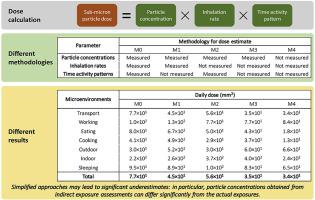Environmental Pollution ( IF 7.6 ) Pub Date : 2020-07-11 , DOI: 10.1016/j.envpol.2020.115209 Mauro Scungio 1 , Valeria Rizza 2 , Luca Stabile 3 , Lidia Morawska 4 , Giorgio Buonanno 5

|
In everyday life, people are exposed to different concentrations of airborne particles depending on the microenvironment where they perform their different activities. Such exposure can lead to high sub-micron particle doses. The received dose depends on particle concentration to which people are exposed (typically expressed in terms of number or surface area), time spent in each activity or microenvironment (time activity pattern) and amount of air inhaled (inhalation rate). To estimate an actual value of the received dose, all these parameters should be measured under real-life conditions; in fact, the concentrations should be measured on a personal scale (i.e. through a direct exposure assessment), whereas time activity patterns and inhalation rates specific to the activity performed should be considered. The difficulties in obtaining direct measurements of these parameters usually lead to adopt time activity patterns and inhalation rates already available in scientific literature for typical populations, and local outdoor particle concentrations measured with fixed monitoring stations and extrapolated for all the other microenvironments.
To overcome these limitations, we propose a full-field method for estimating the received dose of a population sample, in which all the parameters (concentration levels, time activity patterns and inhalation rates) are measured under real-life conditions (also including the inhalation rates, that were evaluated on the basis of the measured heart rates). Specifically, 34 volunteers were continuously monitored for seven days and the data of sub-micron particle concentrations, activities performed, and inhalation rates were recorded. The received dose was calculated with the proposed method and compared with those obtained from different simplified methodologies that consider typical data of particle concentrations, time activity patterns and inhalation rates obtained from literature. The results show that, depending on the methodology used, the differences in the received daily dose can be significant, with a general underestimation of the most simplified method.
中文翻译:

方法论对人群在全天活动中接受的颗粒表面积剂量估算的影响。
在日常生活中,人们会根据其执行不同活动的微环境而暴露于不同浓度的空气传播颗粒。这样的暴露可能导致高亚微米颗粒剂量。所接收的剂量取决于人们所接触的颗粒浓度(通常以数量或表面积表示),每种活动或微环境所花费的时间(时间活动模式)以及所吸入的空气量(吸入率)。为了估算接收剂量的实际值,应在实际条件下测量所有这些参数。实际上,浓度应该以个人规模进行测量(即通过直接接触评估),而应考虑时间活动模式和特定于所进行活动的吸入率。
为了克服这些限制,我们提出了一种用于估计人群样本接收剂量的全视野方法,其中所有参数(浓度水平,时间活动模式和吸入速率)均在真实条件下(包括吸入)进行测量率,即根据测得的心率进行评估)。具体来说,连续7天对34名志愿者进行了监测,并记录了亚微米颗粒浓度,进行的活动和吸入率的数据。用所提出的方法计算接收到的剂量,并将其与从不同简化方法中获得的剂量进行比较,这些方法考虑了从文献中获得的典型的颗粒浓度,时间活动模式和吸入率数据。结果表明,根据所使用的方法,











































 京公网安备 11010802027423号
京公网安备 11010802027423号